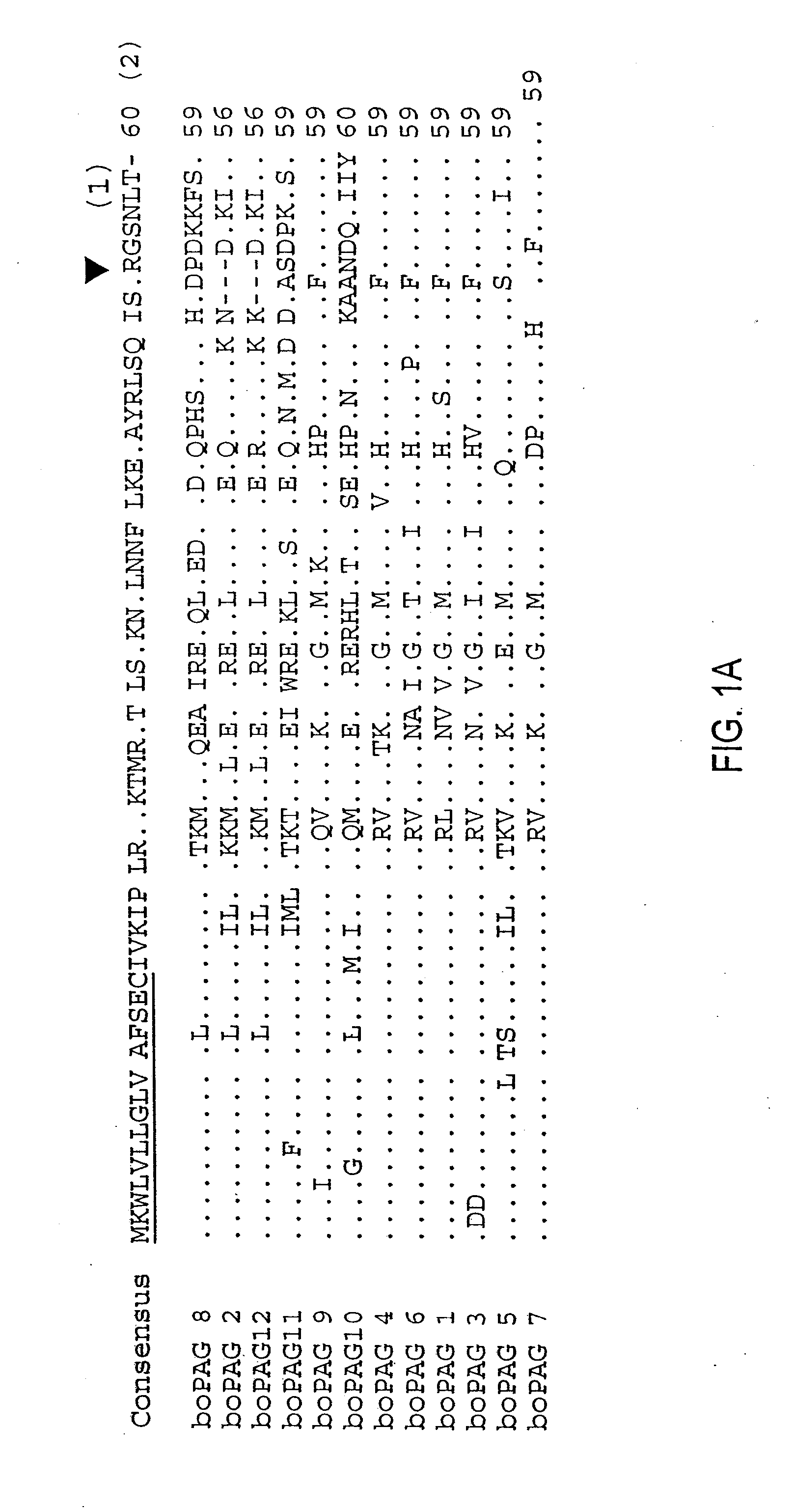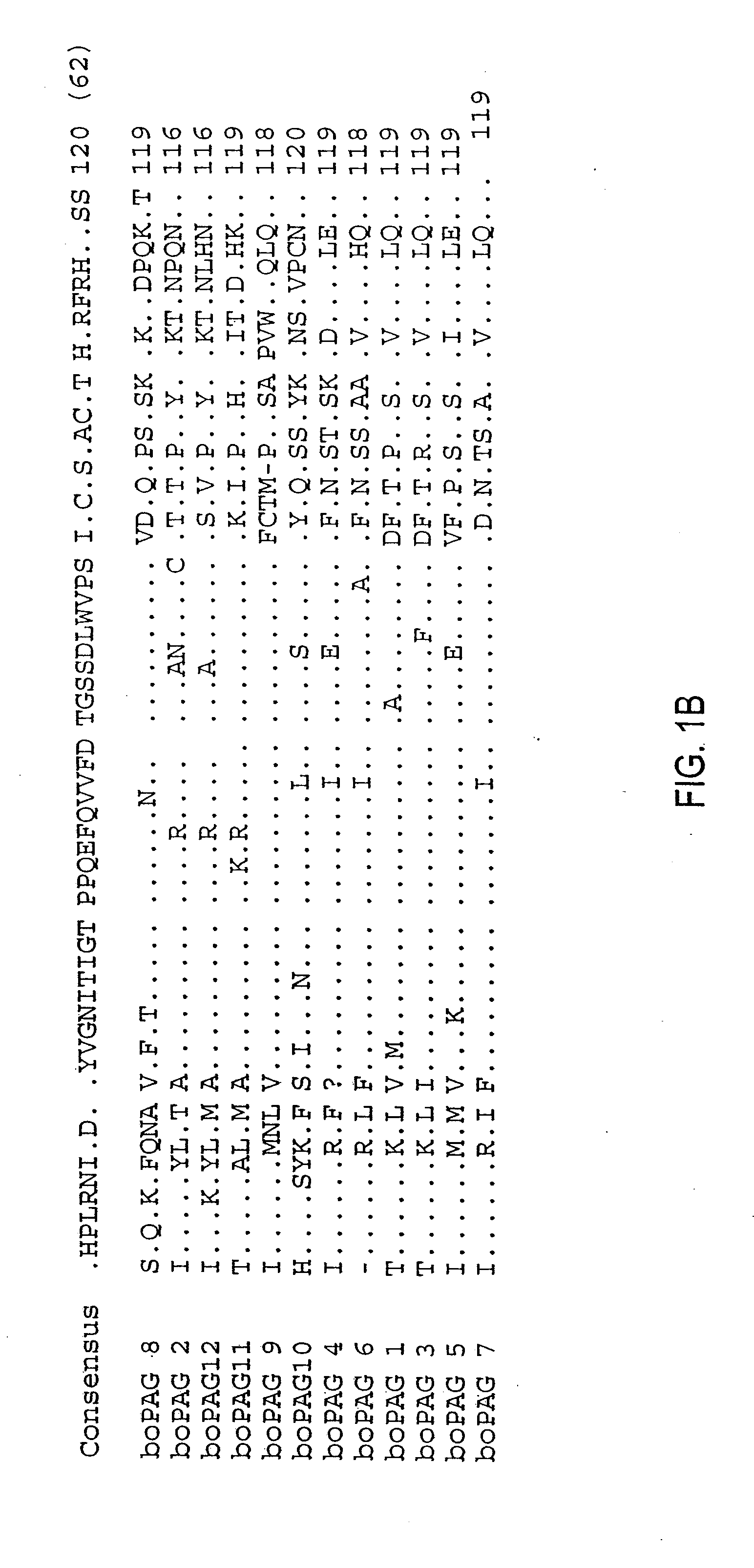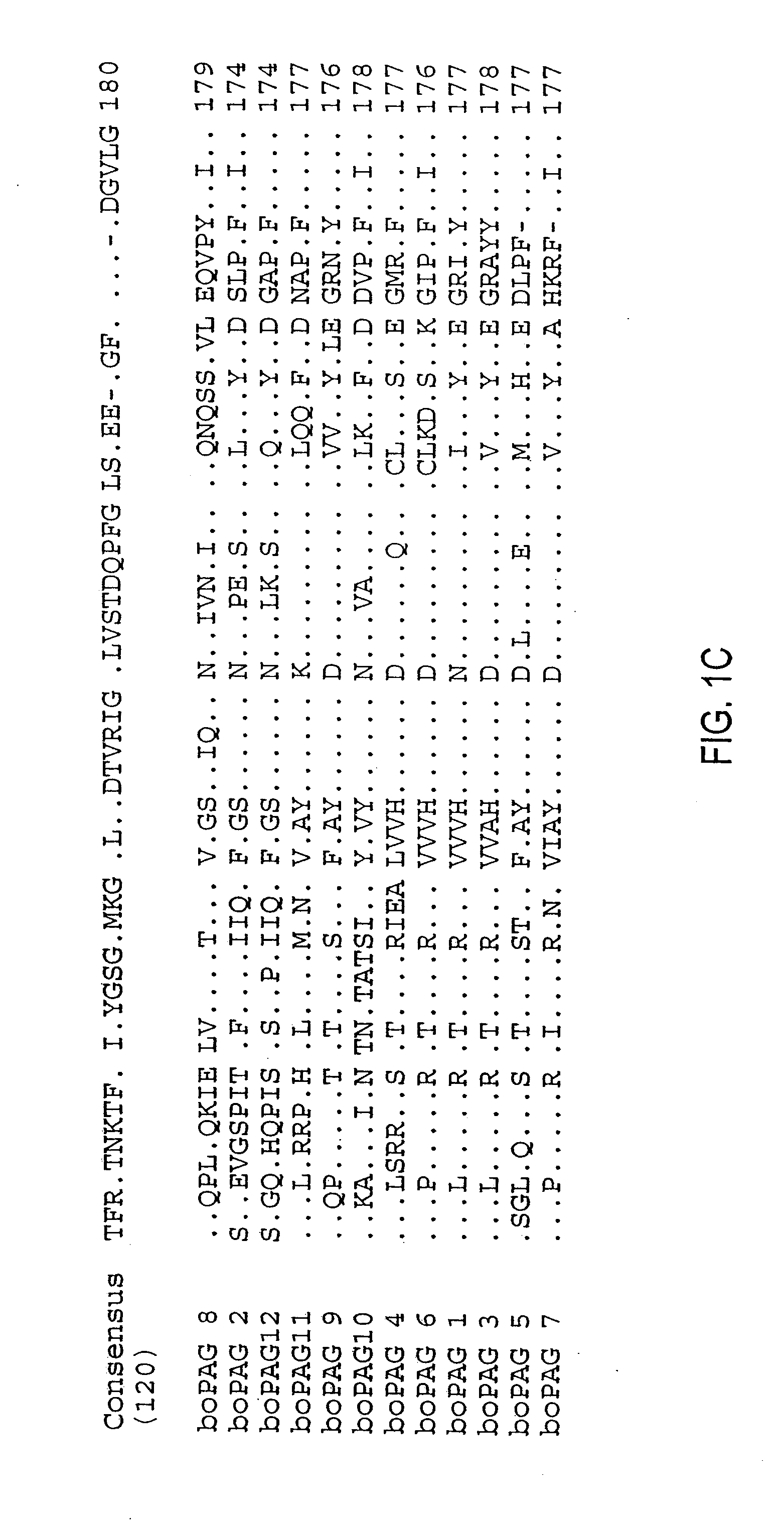Compositions and methods for early pregnancy diagnosis
a technology of early pregnancy and composition, applied in the field of veterinary medicine, reproductive biology and diagnostics, can solve the problems of inability to accurately predict the pregnancy, the measurement of milk or serum progesterone around the day 18-22 yields unacceptably high false positive rates, and the cost of instruments, etc., to achieve sensitive and accurate results
- Summary
- Abstract
- Description
- Claims
- Application Information
AI Technical Summary
Benefits of technology
Problems solved by technology
Method used
Image
Examples
example 1
A. Example 1
Cloning of boPAGs from Placental Tissues Early in Pregnancy
[0186] Materials and Methods:
[0187] Bovine PAG transcripts were cloned from day 19 and 25 placentae. RNA from six (Simmental×Hereford) placentas at day 25 of pregnancy was used to construct a cDNA library in λZAPII (Clontech, Palo Alto, Calif.). The library was screened with a mixed probe of 32P-labeled bovine, ovine and porcine PAG1 and PAG2, and equine PAG cDNA (Xie et al., 1991, Xie et al., 1994; Xie et al., 1995; Szafranska et al., 1995). The positive clones were isolated and analyzed for the size of inserts by PCR™ and restriction endonuclease digestion. Sixteen clones of the expected length were partially sequenced. The second screening identified boPAG transcripts that reacted with an anti-boPAG1 antiserum (Zoli et al., 1991; Xie et al., 1991). Duplicate filter screening was employed to increase the frequency of isolation of full length clones. The first filter was allowed to react with antiserum to iden...
example 2
B. Example 2
Structural Relationships Among boPAGS
[0194] Materials and Methods:
[0195] The amino acid sequences of various PAGs and pepsin were assembled into multiple sequence alignments with the Pile Up Program of the Wisconsin GCG Package, Version 9.0 (Madison, Wis.). A distance matrix was then created (Program Distances) and a phylogenetic tree constructed by a neighbor-joining procedure (Nei, 1987).
[0196] Results:
[0197] The data in FIG. 5 is a phylogenetic tree relating all of the bovine PAGs (FIG. 1) and ovine PAGs (FIG. 2) that have so far been cloned as cDNA. The methods used for cloning these PAG cDNAs is described by Xie et al., 1997b. Also included in FIG. 5 are rabbit pepsinogen F and porcine pepsinogen A, the aspartic proteinases structurally most similar to PAGs. Note that the bovine and ovine PAGs fall largely into two structurally related groups. One contains boPAG2, -10, -11, and -12, along with ovPAG2 and ovPAG5. The other is comprised of boPAG1, 3, 4, 5, 6, 7, a...
example 3
C. Example 3
Certain Early PAGs are Expressed in Trophoblast Binucleate Cells and in the Syncytium Formed Between Trophectoderm and Uterine Epithelium
[0198] Materials and Methods:
[0199] Riboprobes (cRNA) were prepared by using the Riboprobe Preparation System (Promega, Wis., USA). Briefly, two regions of the boPAG cDNA, representing poorly conserved sequences, were used as the probe in situ hybridization (and ribonuclease protection assay: see next section). The first fragment (536 bp) of boPAG2, 4, 8, 9 or 11 cDNA, that was in the region of exons 6, 7, 8 and 9, was amplified by using PCR™ with a pair of primers (Forward 5′CCTCTTTTGCCTTCTACTTGA3′ (SEQ ID NO:18, and Reverse 5′GCGCTCGAGTTACACTGCCCGTGCCAGGC3′ (SEQ ID NO:19). However, another region (407 bp) was chosen for boPAG1, 5, 6 and 7 cDNA, corresponding to exons 3, 4 and 5. Again it was amplified by a PCR™ procedure with two well conserved primers (Forward B: 5′TGGGTAACATCACCATTGGAA3′ (SEQ ID NO:20, Reverse B: 5′TTTCTGAGCCTGTTT...
PUM
| Property | Measurement | Unit |
|---|---|---|
| molecular weight | aaaaa | aaaaa |
| molecular weight | aaaaa | aaaaa |
| concentration | aaaaa | aaaaa |
Abstract
Description
Claims
Application Information
 Login to View More
Login to View More - R&D
- Intellectual Property
- Life Sciences
- Materials
- Tech Scout
- Unparalleled Data Quality
- Higher Quality Content
- 60% Fewer Hallucinations
Browse by: Latest US Patents, China's latest patents, Technical Efficacy Thesaurus, Application Domain, Technology Topic, Popular Technical Reports.
© 2025 PatSnap. All rights reserved.Legal|Privacy policy|Modern Slavery Act Transparency Statement|Sitemap|About US| Contact US: help@patsnap.com



